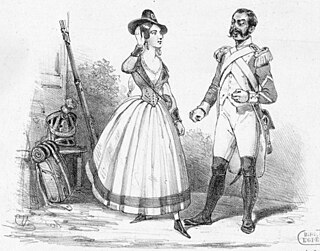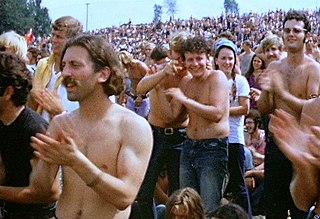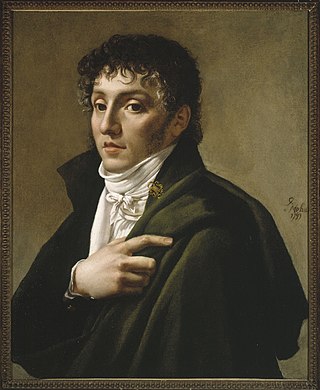
The following outline is provided as an overview of and topical guide to theatre:

La fille du régiment is an opéra comique in two acts by Gaetano Donizetti, set to a French libretto by Jules-Henri Vernoy de Saint-Georges and Jean-François Bayard. It was first performed on 11 February 1840 by the Paris Opéra-Comique at the Salle de la Bourse.

The Vienna New Year's Concert is an annual concert of classical music performed by the Vienna Philharmonic on the morning of New Year's Day in Vienna, Austria. The concert occurs at the Musikverein at 11:15. The orchestra performs the same concert programme on 30 December, 31 December, and 1 January but only the last concert is regularly broadcast on radio and television.

Chinese Opera is a form of theatre in China that combines singing, acting, and elaborate costumes. Topics are based on Chinese history, mythology, and literature. Over its historical evolution, it has incorporated various art forms such as music, song and dance, martial arts, acrobatics, costume and make-up art, and literature. It has highly formalized roles, performed by professional actors each trained for specific roles. Exaggerated features and colors make the roles easily identifiable.

Noh is a major form of classical Japanese dance-drama that has been performed since the 14th century. Developed by Kan'ami and his son Zeami, it is the oldest major theater art that is still regularly performed today. Although the terms Noh and nōgaku are sometimes used interchangeably, nōgaku encompasses both Noh and kyōgen. Traditionally, a full nōgaku program included several Noh plays with comedic kyōgen plays in between; an abbreviated program of two Noh plays with one kyōgen piece has become common today. Optionally, the ritual performance Okina may be presented in the very beginning of nōgaku presentation.

Cantonese opera is one of the major categories in Chinese opera, originating in southern China's Guangdong Province. It is popular in Guangdong, Guangxi, Hong Kong, Macau and among Chinese communities in Southeast Asia. Like all versions of Chinese opera, it is a traditional Chinese art form, involving music, singing, martial arts, acrobatics, and acting.

Peking opera, or Beijing opera, is the most dominant form of Chinese opera, which combines instrumental music, vocal performance, mime, martial arts, dance and acrobatics. It arose in Beijing in the mid-Qing dynasty (1644–1912) and became fully developed and recognized by the mid-19th century. The form was extremely popular in the Qing court and has come to be regarded as one of the cultural treasures of China. Major performance troupes are based in Beijing, Tianjin and Shanghai. The art form is also preserved in Taiwan, where it is also known as Guójù. It has also spread to other regions such as the United States and Japan.

A clap is the percussive sound made by striking together two flat surfaces, as in the body parts of humans or animals. Humans clap with the palms of their hands, often quickly and repeatedly to express appreciation or approval, but also in rhythm as a form of body percussion to match the sounds in music, dance, chants, hand games, and clapping games.

A standing ovation is a form of applause where members of a seated audience stand up while applauding after extraordinary performances of particularly high acclaim. In Ancient Rome returning military commanders whose victories did not quite meet the requirements of a triumph but which were still praiseworthy were celebrated with an ovation instead, from the Latin ovo, "I rejoice". The word's use in English to refer to sustained applause dates from at least 1831.

Experimental theatre, inspired largely by Wagner's concept of Gesamtkunstwerk, began in Western theatre in the late 19th century with Alfred Jarry and his Ubu plays as a rejection of both the age in particular and, in general, the dominant ways of writing and producing plays. The term has shifted over time as the mainstream theatre world has adopted many forms that were once considered radical.

Booing is an act of publicly showing displeasure for someone or something, such as an entertainer or an athlete, by loudly yelling "Boo!" and sustaining the "oo" sound by holding it out. People may also make hand signs such as the thumbs down sign.

A claque is an organized body of professional applauders in French theatres and opera houses. Members of a claque are called claqueurs.

Theatre of China has a long and complex history. Traditional Chinese theatre, generally in the form of Chinese opera, is musical in nature. Chinese theatre can trace its origin back a few millennia to ancient China, but the Chinese opera started to develop in the 12th century. Western forms like the spoken drama, western-style opera, and ballet did not arrive in China until the 20th century.

A curtsy is a traditional gendered gesture of greeting, in which a girl or woman bends her knees while bowing her head. In Western culture it is the feminine equivalent of bowing by males. Miss Manners characterizes its knee bend as deriving from a "traditional gesture of an inferior to a superior." The word "curtsy" is a phonological change from "courtesy" known in linguistics as syncope.
"Break a leg" is a typical English idiom used in the context of theatre or other performing arts to wish a performer "good luck". An ironic or non-literal saying of uncertain origin, "break a leg" is commonly said to actors and musicians before they go on stage to perform or before an audition. Though the term likely originates in German, the English expression is first attributed in the 1930s or possibly 1920s, originally documented without specifically theatrical associations. Among professional dancers, the traditional saying is not "break a leg", but the French word merde.

An encore is an additional performance given by performers at the conclusion of a show or concert, usually in response to extended applause from the audience. They are regarded as the most complimentary kind of applause for performers. Multiple encores are not uncommon, and they initially originated spontaneously, when audiences continued to applaud and demand additional performance from the artists after they had left the stage. However, in modern times they are rarely spontaneous and are usually a pre-planned part of the show.

Concert etiquette refers to a set of social norms observed by those attending musical performances. These norms vary depending upon the type of music performance and can be stringent or informal.

A studio audience is an audience present for the recording of all or part of a television program or radio program. The primary purpose of the studio audience is to provide applause and/or laughter to the program's soundtrack.

Les Millions d'Arlequin also known under the title Harlequinade is a ballet comique in two acts and two tableaux with libretto and choreography by Marius Petipa and music by Riccardo Drigo. It was first presented at the Theatre of the Imperial Hermitage Museum by the Imperial Ballet in Saint Petersburg on 23 February [O.S. 10 February] 1900. The ballet was given a second premiere with the same cast at the Imperial Mariinsky Theatre on 26 February [O.S. 13 February] 1900.

Le jeune Henri is an opera by the French composer Étienne Méhul. It takes the form of a comédie mêlée de musique in two acts. The libretto, by Jean-Nicolas Bouilly, is based on an episode from the life of King Henri IV of France. It was first performed on 1 May 1797 at the Théâtre Favart, Paris. The opera was a failure but the overture was warmly applauded and has often been performed separately since. Known as La chasse du jeune Henri, it is a piece of programme music describing the course of a hunt from dawn to the killing of the stag.






















